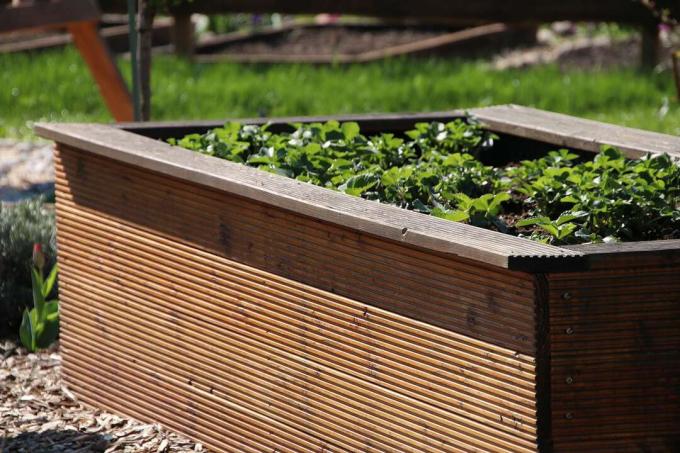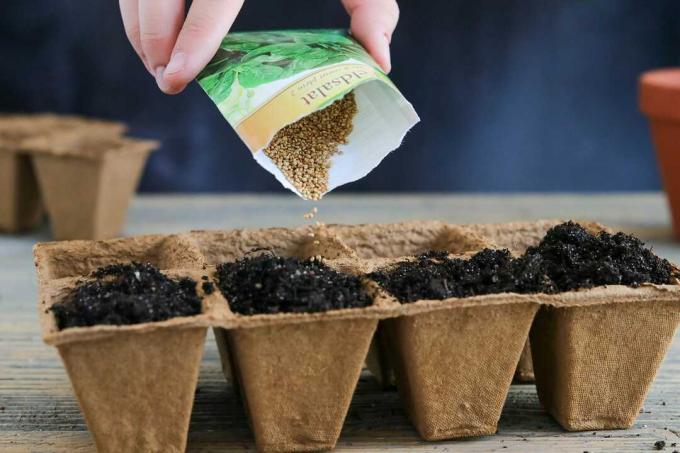
Lamb's lettuce contains a variety of valuable ingredients. You don't need a garden to enjoy the bioactive substances. Because the delicious salad also thrives in raised beds.
In a nutshell
- Lamb's lettuce thrives in raised beds without any problems
- sow in summer or fall
- stagger sowing for a continuous harvest
Table of contents
- Lamb's lettuce
- location and soil
- time
- sowing
- Care
- water the raised bed
- Translucent lid
- Prefer lamb's lettuce
- frequently asked Questions
Lamb's lettuce
Lamb's lettuce (Valerianella locusta) is considered a typical winter salad. But this is only one side of the coin, because the lamb's lettuce – as it is called in Austria – can also be grown in summer. Some varieties even overwinter and are only ready to harvest in spring. However, if it starts to flower, you will have to forego harvesting. But you can simply harvest the seeds and sow them again.

location and soil
Valerinanella locusta loves sunny locations. As weak feeder it gets by with few nutrients and should only be planted in the raised bed in the third year. It is important that the soil is not too dry. A humus-rich, calcareous and sandy soil should be chosen for the lettuce. You should also remove weeds from the raised bed before sowing and loosen the soil a little.
time
There are different time frames for growing lamb’s lettuce in raised beds. For early summer harvest, plant lettuce in April. In early autumn, sow the lettuce in July and August. For lamb's lettuce, which is to be harvested in winter or next spring, sow in September and October. For which time window the lamb's lettuce is suitable depends on the variety.
sowing
The common lamb's lettuce is not difficult to grow and is particularly suitable for gardening beginners who want an easy start. Because the nutty winter lettuce is very easy to care for and achieves a quick sense of achievement. For cultivation in raised beds, it is advisable to sow lamb's lettuce in rows. An alternative to this is staggered sowing.
rows
- Row spacing 10 to 15 centimeters
- Draw grooves with a depth of 0.5 to 1 cm
- Sow seeds thinly distributed in the grooves (distance about 10 centimeters)

Staggered sowing
- Shape of a checkerboard pattern
- Leave five to ten centimeters between the individual seeds
If you have sown the lamb's lettuce, cover the seed. For the ground connection, press the ground firmly with a wooden board. Then water the lamb's lettuce.
Care
The germination phase of lamb's lettuce lasts between one and three weeks, depending on the sowing date. During this time, keep the soil moist to keep the germinating seeds from drying out. You should also remove any weeds that appear immediately.

water the raised bed
If the soil in the raised bed is very dry, you should water it well before sowing lamb's lettuce. To avoid waterlogging, reduce the amount of water when watering after sowing.
Translucent lid
To prolong harvest time, place a translucent lid on the lamb's lettuce. A plant protection fleece or plant film is suitable for this. So that the plants under the cover are not attacked by mold (especially false Melthau), you should add the lamb's lettuce every day or every week. air on frost-free days.
Prefer lamb's lettuce
Since Valerinanella locusta is very germinable, you do not have to prefer it for cultivation in raised beds. Preparing young plants can, however, be an advantage if you want to grow the lamb's lettuce on areas that become available late - for example after tomatoes. Proceed as follows:
- Obtain seed cubes or earth balls from specialist retailers
- Press in one seed per cube / ball (maximum one centimeter deep)
- water well
- place in a warm place out of direct sunlight
- always keep moist

A notice: The young plants come into the raised bed when they have developed at least one real pair of leaves. Before planting out, you should get the young lamb's lettuce used to the new conditions by placing it outside for hours during the day.
frequently asked Questions
Good neighbors for lamb's lettuce are, for example Kohlrabi, leeks, onions, strawberries or pole beans. In post-culture sow after tomatoes or cucumbers. Cultivation after legumes is not recommended.
If it gets really cold in winter, you should cover smaller plants with a translucent fleece. Air the lettuce regularly to prevent mold from forming.
Lamb's lettuce that could not be harvested is a good fertilizer for the raised bed. Simply dig the lettuce into the ground as green manure.


